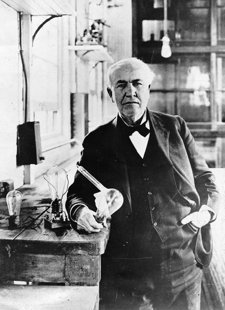The real Thomas Alva Edison was born a bit up the road from my Cincinnati home in in Milan, Ohio, in 1847. His accomplishments are well-known enough that I needn’t enumerate them here.
But when Lou Anders of Pyr asked me to write a “Weird Western” for him, with a strong dose of steampunk, I knew that along with gunslingers and the like, I had to make use of Edison, given the dates of his major breakthroughs.
The Buntline Special, which comes out in December (you can read an excerpt here) had the government move Edison to Tombstone, Arizona for plot purposes, so I asked myself: what would Tombstone look like after he’d been there for awhile?
Well, for one thing, the streets would be illuminated by electric lights as night. So would the houses, the saloons, the dance halls, and just about everything else. But what else would Tom—he’d never be called Thomas in Tombstone—do?
Well, for one thing, most of my principals lived by their weapons. Ned Buntline commissioned the Colt Company to make the Buntline Special—but with a genius like Edison out there, why wouldn’t he go to Tom instead? After all, a Colt pistol, even with the 12-inch barrel Buntline ordered, just fires bullets. But what could an electrical genius design in the way of a hand weapon?
Then there would be primitive (by our standards) but wildly advanced (for 1880) security systems. Step on a porch that was properly wired and a cowboy or gunman would set off alarm. And Tom did a lot of work with photography, so he’d probably add a hidden camera or two that would be activated by an electrical impulse caused when an unwanted visitor put his weight on a hidden wire.
The days of Billy the Kid or Doc Holliday being broken out of jail would be relegated to works of fiction. Tom would rig an electric charge into the metal bars of the jail. Try to free your criminal cohort and you’d still have one hand left to sign your name.
Since I was writing a work of fiction, I got just a little farfetched and esoteric, having Tom design some very lifelike and functional prosthetic limbs, since many arm and leg wounds required amputation at that time. Eventually he designed some fully functional robotic prostitutes, which led to some moral (but non-electric) dilemmas.
He’d have to team up with someone who could construct a horseless stagecoach to his specifications, but Tom certainly was enough of an electrical genius to create a motor to power one once it was built.
More? There’d be electrified wires around a corral to give cattle or horses a mild shock if they tried to get out. (I had the same thing when my daughter had a horse while she was growing up. One little jolt and he learned instantly.)
The photograph was a fait accompli, so there was no need to expand upon it. Ditto his very early work with the flouroscope. And I never got into the wonders Tom could bring to the frontier kitchen of the 1880s, but there’s no question he could have revolutionized it.
Because steampunk seems to require a lot of brass to appeal to its readership, I had Tom team up with Ned Buntline, who historically was just a self-promoting dime novel writer and publicist, but in this universe had created a form of super-hardened and impenetrable brass, and brought many of Tom’s creations off the drawing board and into actual physical being. And having changed Buntline’s occupation, I had Tom design lightweight body armor for Doc and the Earps before the gunfight at the O.K. Corral, which Ned then created.
Nothing except the robots was extrapolated that wasn’t at least theoretically possible, given the amazing Mr. Edison’s historical accomplishments. It gave a very different and steampunkish flavor to a town that has lived a lot longer in fact and in legend than any of the participants could have imagined.
Mike Resnick is the winner of five Hugos and a Nebula. According to Locus he is the all-time leading award winner, living or dead, for short science fiction. He will be the Guest of Honor at the 2012 World Science Fiction Convention.










